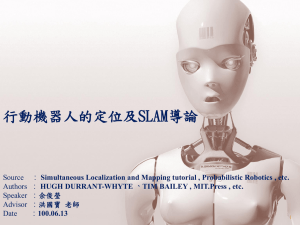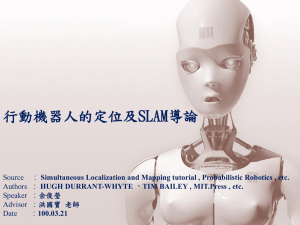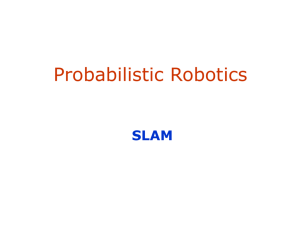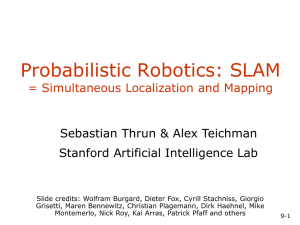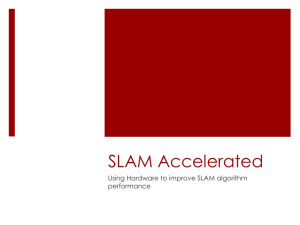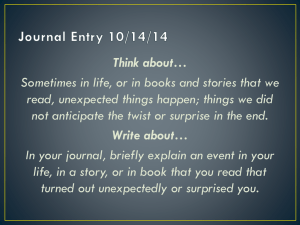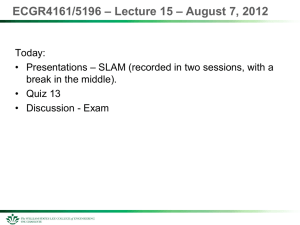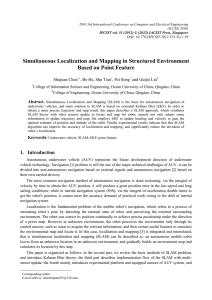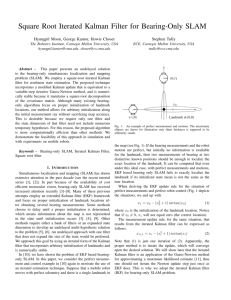SLAM - The School of Electrical Engineering and Computer Science
advertisement
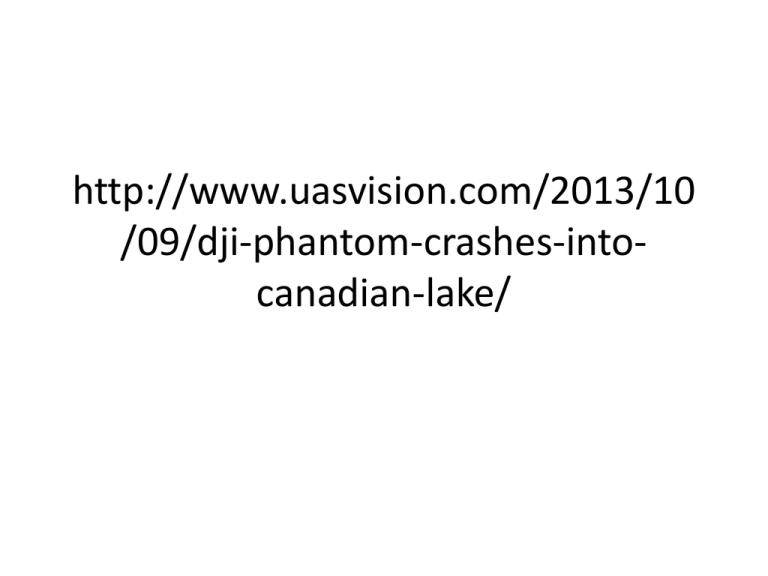
http://www.uasvision.com/2013/10 /09/dji-phantom-crashes-intocanadian-lake/ HW2 • Under door by 11:59pm today • Via Angel by 11:59pm today • (or just hand it to me now) • Any questions? (Can also talk after class.) • Next Monday (10/14) – Tell Me About It: Language and Learning for Human-Robot Interaction – 4:10pm, EME 52 – Cynthia Matuszek is a Ph.D. candidate in Computer Science and Engineering at the University of Washington, studying with Drs. Dieter Fox and Luke Zettlemoyer. Her research focuses on how robots can interact robustly in unconstrained real-world settings. • Next Tuesday – Intro to HRI • Next Thursday – Reaction to “Camera-Based Navigation of a Low-Cost Quadrocopter” – Review • Next next Tuesday – Midterm – Remember, book is in lab if you want to study Due by 11:59pm on Wednesday, 10/16 • http://vision.in.tum.de/_media/spezial/bib/en gel12iros.pdf • Reaction 1 paragraph to ½ a page • What did you find interesting? • What was confusing? • Summarize the paper • What questions does this paper raise? • Any ideas for a future project from this paper? Overview • Histogram Filter – Discrete – Multimodal • Particle Filter – Continuous – Multimodal • Kalman Filter – Continuous – Unimodal Example Example Right Example Example Right Kalman Filter Model σ2 𝜇 Gaussian (in 1𝐷 for now) Area under the curve sums to 1 Kalman Filter Gain Information Bayes Rule (Multiplication) Initial Belief Lose Information Sense Gaussian: μ, σ2 Move Convolution (Addition) Measurement Example μ, 𝜎σ22 ) Prior Position Estimate (𝜇, v, r𝑟2 2 ) Measurement Estimate (𝜈, Measurement Example μ, 𝜎σ22 ) Prior Position Estimate (𝜇, v, r𝑟2 2 ) Measurement Estimate (𝜈, Where is the new mean 𝜇′? Measurement Example μ, 𝜎σ22 ) Prior Position Estimate (𝜇, v, r𝑟2 2 ) Measurement Estimate (𝜈, What is the new covarance 𝜎σ22’? ′? Measurement Example μ, 𝜎σ22 ) Prior Position Estimate (𝜇, v, r𝑟2 2 ) Measurement Estimate (𝜈, New Estimate (𝜇 𝜎22’′) μ',′ , σ To calculate, go through and multiply the two Gaussians and renormalize to sum to 1 Also, the multiplication of two Gaussian random variables is itself a Gaussian Another point of view… μ, 𝜎σ2 ) : p(x) Prior Position Estimate (𝜇, v, r𝑟2 2 ) : p(z|x) Measurement Estimate (𝜈, : p(x|z) New Estimate (𝜇 𝜎22’′) μ',′ , σ Example Prior Position Estimate (10,4) Measurement Estimate (12, 4) Example Prior Position Estimate (10,4) Measurement Estimate (12, 4) Example Prior Position Estimate (10,8) Measurement Estimate (13, 2) μ’=12.4 σ2’=1.6 Kalman Filter Lose Information Sense Initial Belief Gaussian: μ, σ2 Move Convolution (Addition) Motion Update • For motion Model of motion noise u, r2 μ’=μ+u σ2’=σ2+r2 Motion Update • For motion Prior Position Estimate (8,4) Movement Estimate (10, 6) Model of motion noise u, r2 μ’=μ+u σ2’=σ2+r2 Motion Update • For motion Prior Position Estimate (8,4) Movement Estimate (10, 6) Model of motion noise u, r2 μ’=μ+u=18 σ2’=σ2+r2=10 Kalman Filter μ’=μ+u=18 σ2’=σ2+r2=10 Sense Initial Belief Gaussian: μ, σ2 Move Kalman Filter in Multiple Dimensions 2D Gaussian Implementing a Kalman Filter example VERY simple model of robot movement: What information do our sensors give us? Implementing a Kalman Filter example F H H = [1 0] Implementing a Kalman Filter • • • • • estimate P’ uncertainty covariance state transition matrix u motion vector F motion noise • measurement • measurement function • measurement noise • identity matrix Summary • Kalman Filter • Particle Filter – Continuous – Unimodal – Continuous – Multimodal – Harder to implement – More efficient – Requires a good starting guess of robot location – Easier to implement – Less efficient – Does not require an accurate prior estimate SLAM • Simultaneous localization and mapping: Is it possible for a mobile robot to be placed at an unknown location in an unknown environment and for the robot to incrementally build a consistent map of this environment while simultaneously determining its location within this map? http://flic.kr/p/9jdHrL Three Basic Steps • The robot moves – increases the uncertainty on robot pose – need a mathematical model for the motion – called motion model Three Basic Steps • The robot discovers interesting features in the environment – called landmarks – uncertainty in the location of landmarks – need a mathematical model to determine the position of the landmarks from sensor data – called inverse observation model Three Basic Steps • The robot observes previously mapped landmarks – uses them to correct both self localization and the localization of all landmarks in space – uncertainties decrease – need a model to predict the measurement from predicted landmark location and robot localization – called direct observation model How to do SLAM How to do SLAM How to do SLAM How to do SLAM How to do SLAM How to do SLAM How to do SLAM How to do SLAM How to do SLAM The Essential SLAM Problem SLAM Paradigms • Some of the most important approaches to SLAM: – Extended Kalman Filter SLAM (EKF SLAM) – Particle Filter SLAM (FAST SLAM) – GraphSLAM EKF Slam • Keep track of combined state vector at time t: – – – – x, y, θ m1,x, m1,y, s1 … mN,x, mN,y, sN • m = estimated coordinates of a landmark • s = sensor’s signature for this landmark • Very similar to EKF localization, starting at origin EKF-SLAM Grey: Robot Pose Estimate White: Landmark Location Estimate Visual Slam • Single Camera • What’s harder? • How could it be possible? GraphSLAM • SLAM can be interpreted as a sparse graph of nodes and constraints between nodes. GraphSLAM • SLAM can be interpreted as a sparse graph of nodes and constraints between nodes. • nodes: robot locations and map-feature locations • edges: constraints between ▫ consecutive robot poses (given by the odometry input u) ▫ robot poses and the features observed from these poses. GraphSLAM • Key property: constraints are not to be thought as rigid constraints but as soft constraints ▫ Constraints acting like springs • Solve full SLAM by relaxing these constraints ▫ get the best estimate of the robot path and the environment map by computing the state of minimal energy of this spring mass network GraphSLAM GraphSLAM GraphSLAM GraphSLAM 1. Build graph 2. Inference: solve system of linear equations to get map and path GraphSLAM • The update time of the graph is constant. • The required memory is linear in the number of features. • Final graph optimization can become computationally costly if the robot path is long. • Impressing results with even hundred million features.
